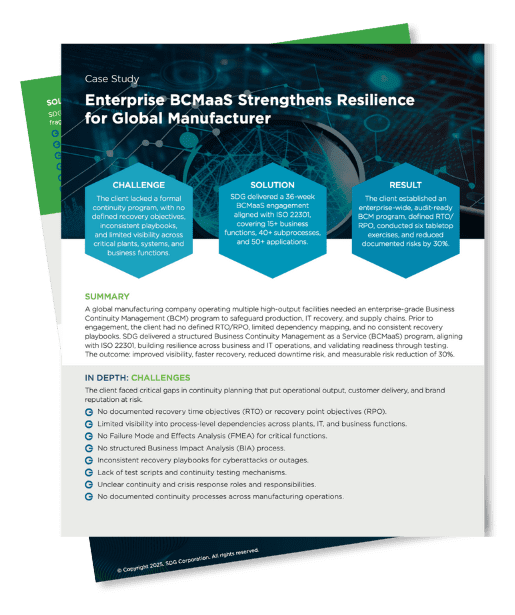Download the Case Study Now
A global manufacturer partnered with SDG to build an enterprise-wide Business Continuity Management program. In 36 weeks, SDG delivered a BCMaaS engagement aligned with ISO 22301, establishing recovery objectives, standardized playbooks, and validated exercises. The result: an audit-ready program with improved visibility, faster recovery, and a 30% reduction in documented risks.
→ Download the full case study to discover how BCMaaS aligned with ISO 22301 transformed continuity into a tested, enterprise-grade capability.

Challenge
The client lacked a formal continuity program, with no defined recovery objectives, inconsistent playbooks, and limited visibility across critical plants, systems, and business functions.
Solution
SDG delivered a 36-week BCMaaS engagement aligned with ISO 22301, covering 15+ business functions, 40+ subprocesses, and 50+ applications.
Result
The client established an enterprise-wide, audit-ready BCM program, defined RTO/ RPO, conducted six tabletop exercises, and reduced documented risks by 30%.
Summary
A global manufacturing company operating multiple high-output facilities needed an enterprise-grade Business Continuity Management (BCM) program to safeguard production, IT recovery, and supply chains. Prior to engagement, the client had no defined RTO/RPO, limited dependency mapping, and no consistent recovery playbooks. SDG delivered a structured Business Continuity Management as a Service (BCMaaS) program, aligning with ISO 22301, building resilience across business and IT operations, and validating readiness through testing. The outcome: improved visibility, faster recovery, reduced downtime risk, and measurable risk reduction of 30%.
In Depth: Challenges
The client faced critical gaps in continuity planning that put operational output, customer delivery, and brand reputation at risk.
-
- No documented recovery time objectives (RTO) or recovery point objectives (RPO).
- Limited visibility into process-level dependencies across plants, IT, and business functions.
- No Failure Mode and Effects Analysis (FMEA) for critical functions.
- No structured Business Impact Analysis (BIA) process.
- Inconsistent recovery playbooks for cyberattacks or outages.
- Lack of test scripts and continuity testing mechanisms.
- Unclear continuity and crisis response roles and responsibilities.
- No documented continuity processes across manufacturing operations.
Solution
SDG implemented a structured BCMaaS program aligned with ISO 22301 that elevated resilience from fragmented efforts to a standardized, business-driven capability.
- Designed and implemented a top-management-led BCM framework aligned with ISO 22301.
- Executed a standardized BIA and FMEA across 15+ functions and 40+ subprocesses.
- Defined and validated RTOs and RPOs for 50+ applications and critical processes.
- Developed comprehensive continuity and recovery plans with disruption-specific playbooks.
- Delivered six scenario-based tabletop exercises to test recovery effectiveness.
- Updated the enterprise risk register and linked findings directly to continuity planning.
- Transitioned program into a managed services model for ongoing plan maintenance and testing.
Results
The engagement delivered resilience that was measurable, tested, and trusted by leadership, enabling the business to operate with greater assurance in the face of disruption.
- 36-week delivery of a complete, enterprise-wide BCM program.
- 15+ functions and 40+ subprocesses fully documented, assessed, and prioritized.
- Defined RTO/RPO for 50+ applications, closing major operational and IT visibility gaps.
- Six tabletop exercises executed, strengthening cross-functional coordination.
- Documented risks reduced by 30% through targeted mitigation.
- Audit-ready alignment with ISO 22301, enabling future certification readiness.
Conclusion
By partnering with SDG, the client transformed continuity from a compliance gap into a strategic advantage. The BCMaaS program not only delivered a repeatable framework but also gave leadership confidence in their ability to withstand disruption, protect stakeholders, and sustain operations under pressure. With improved visibility, faster recovery, and measurable risk reduction, the client now operates a scalable resilience model that supports business growth, protects brand value, and strengthens long-term risk governance.



